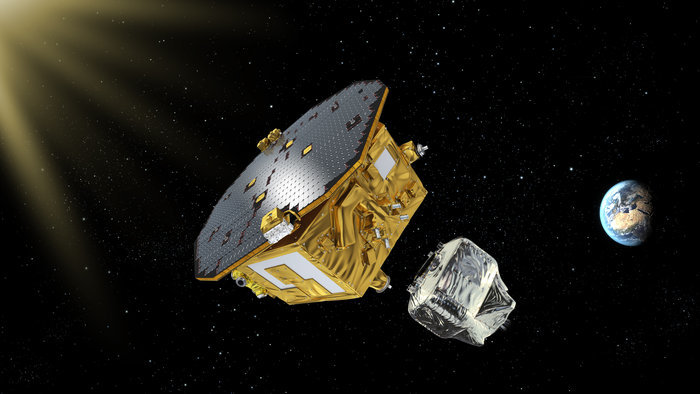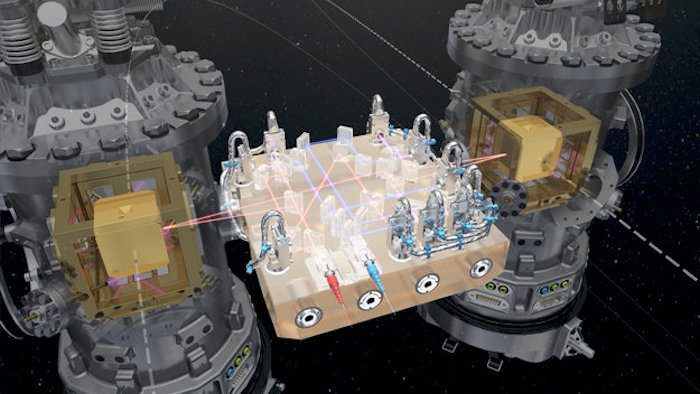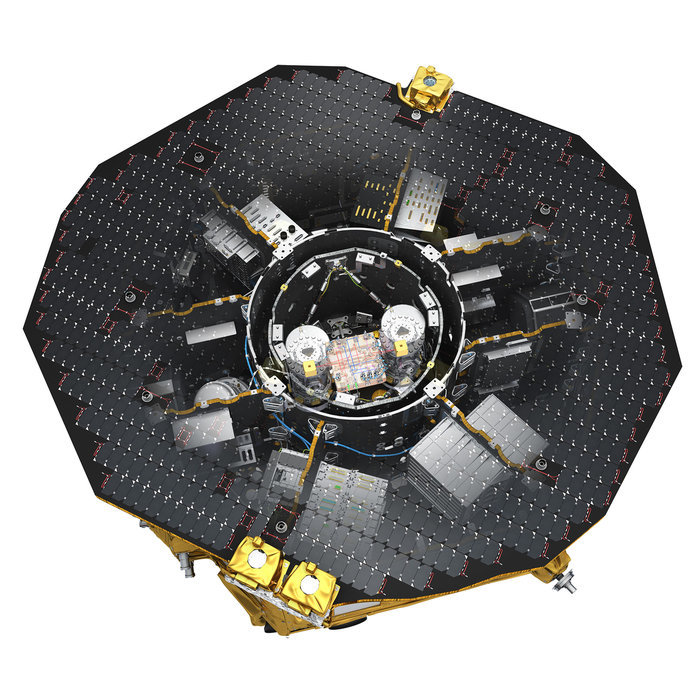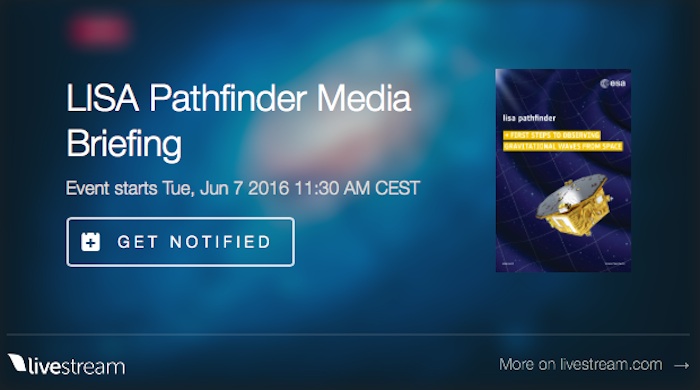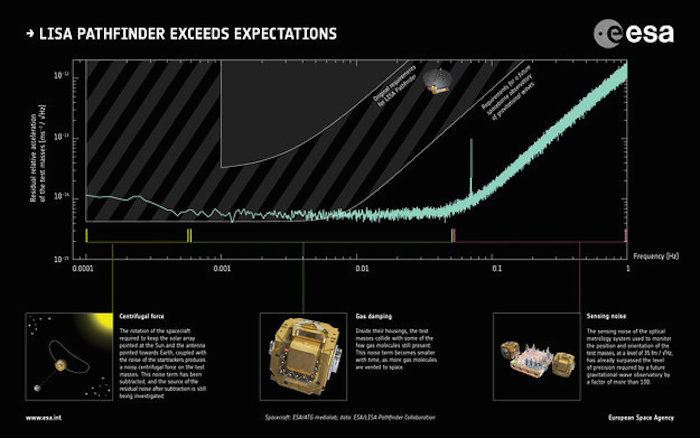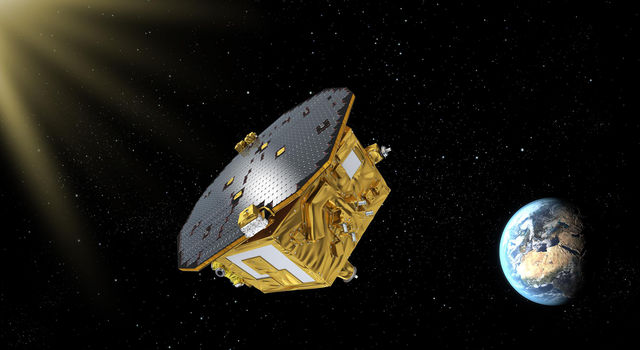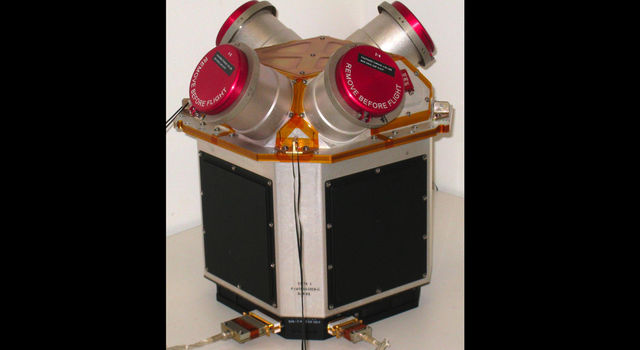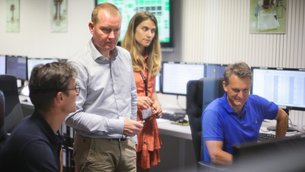Earlier this year, scientists announced the detection of gravitational waves—Einstein’s ripples in spacetime—for the first time on Earth. Those ripples are now reverberating through NASA, nudging the agency to mend fences with the European Space Agency (ESA) and rejoin an ambitious mission, called the Laser Interferometry Space Antenna (LISA), to study gravitational waves from space.
This week, at the 11th LISA symposium in Zürich, Switzerland, a NASA official said he was ready to rejoin the LISA mission, which the agency left in 2011. Meanwhile, ESA says it is trying to move the launch of the mission up several years from 2034. “This is a very important meeting,” says David Shoemaker, a gravitational wave physicist at the Massachusetts Institute of Technology in Cambridge. “It feels like a turning point.”
Plans for LISA date back more than 2 decades. Three separate spacecraft, flying millions of kilometers apart from each other at the vertices of a giant triangle, would precisely measure their mutual separations using sensitive lasers, and thus be capable of detecting low-frequency ripples in spacetime. The objects causing these low-frequency ripples—such as orbiting supermassive black holes at the centers of distant galaxies—would be different from the higher frequency ripples, emitted by collisions of much smaller black holes, that have so far been detected on Earth.
Originally, LISA was conceived as a joint ESA-NASA mission. Both partners would pay 50% of the mission cost, estimated at some $2 billion. But in April 2011, NASA dropped out of the collaboration because of budgetary problems, and the program was almost killed. “The next year, the LISA symposium felt like a funeral,” recalls astrophysicist Paul McNamara of ESA’s space research and technology center ESTEC in Noordwijk, the Netherlands.
Then, in 2013, a trimmed-down, €1 billion version of LISA was selected by ESA as its L3 mission—the third large mission in its Cosmic Vision 2020 program. Called eLISA (where the “e” euphemistically stands for “evolved”), it would have less capability and sensitivity than the original design. Launch was foreseen for 2034. NASA expressed interest to become a minor partner, providing technological support.
But things have changed a lot in the past few years. ESA’s technology demonstrator LISA Pathfinder, launched in December 2015, has performed flawlessly, says McNamara, who is the mission’s project scientist. Then, in February, the ground-based Laser Interferometer Gravitational-Wave Observatory experiment announced that it had bagged its first direct detections.
In June, a NASA-appointed L3 Study Team presented its interim report, suggesting ways for the agency to rejoin the program as a senior partner. And on 15 August, a midterm assessment of the National Academy of Sciences’s (NAS) 2010 Decadal Report, which reviews U.S. priorities for astronomy and astrophysics, strongly recommended NASA to restore support to the space observatory this decade, and to help restore the mission to its original full capacity.
It now looks like the recommendations are taking effect. At the Zürich meeting, Paul Hertz, the director of NASA’s astrophysics division, said: “2011 saw the dissolution of our original LISA partnership. But I’m here to move forward from that.” NASA’s contribution may not get back to 50%, but according to the NAS report, what’s required is “a significantly larger U.S. contribution than the $150 million […] currently being considered”.
Meanwhile, ESA’s Director of Science Alvaro Giménez in Madrid announced that the call for mission concepts for eLISA will be brought forward from 2018 to next month. “We want to make your dreams come true,” he told the gravitational-wave scientists at the meeting. “Although 2029 is probably too optimistic, we might be able to launch the mission a few years earlier, somewhere in the early 2030s.” According to Giménez, not restoring a much stronger partnership with NASA is now almost unthinkable.
Scientists at the meeting were pleased. “When we launch 14 or 15 years from now, this meeting will be seen as the rebirth of LISA,” says Karsten Danzmann of the Albert Einstein Institute in Hannover, Germany, who is LISA Pathfinder’s co–principal investigator.
Adds Shoemaker: “Let’s drop the ‘e’ in eLISA from now on. There’s only one LISA again.”
Quelle: Science
-
Update: 20.11.2016
.
NASA Microthrusters Achieve Success on ESA's LISA Pathfinder
A next-generation technology demonstration mission has just passed a big milestone.
The Space Technology 7 Disturbance Reduction System (ST7-DRS) is a system of thrusters, advanced avionics and software managed by NASA's Jet Propulsion Laboratory, Pasadena, California. It has been flying on the European Space Agency's LISA Pathfinder spacecraft, which launched from Kourou, French Guiana on Dec. 3, 2015 GMT (Dec. 2 PST). As of Oct. 17, the system had logged roughly 1,400 hours of in-flight operations and met 100 percent of its mission goals.
Most thrusters are designed to move a spacecraft, but ST7-DRS has a different purpose: to hold Pathfinder as perfectly still as possible. This allows the spacecraft to test technologies used in the detection of gravitational waves, whose effects are so miniscule that it requires extreme steadiness to detect them.
Just how steady is that? Steady enough that "position noise" -- subtle vibrations in Pathfinder's position -- won't exceed 2 nanometers. That's about the diameter of a DNA helix. This kind of precision is needed to counteract the biggest disturbance to Pathfinder: the pressure from sunlight pushing on the spacecraft (about 25 micronewtons).
"Here's another way of thinking about it: when the thrusters fire at full throttle, they produce a maximum force of 30 micronewtons -- equivalent to the weight of a mosquito landing on the spacecraft," said John Ziemer of JPL, ST7-DRS systems lead. "To maintain our precise position, the thrusters can be controlled in 0.1 micronewton increments, equivalent to the weight of that mosquito's antenna."
Balancing all the disturbances on the spacecraft allows Pathfinder's instruments to stay in near-perfect free fall. This lays the groundwork for a future Pathfinder-type mission, which will need this kind of stability to cancel out any force other than the subtle tug of gravitational waves, produced by supermassive objects like black holes.
"This achievement represents the last hurdle for this microthruster technology development, which the project has been chartered to perform," said JPL's Phil Barela, project manager for ST7-DRS. "Our successful development and demonstration of this electrospray technology will pave the way for future gravitational wave missions, or other missions requiring precise control of spacecraft position and pointing."
Large space observatories and spacecraft formation-flying missions could both benefit from this technology, Barela added.
ST7-DRS is a system of eight thrusters positioned on either side of the Pathfinder spacecraft. Each thruster emits microscopic liquid droplets called a colloid electrospray, which are created and charged through an electric field. These ionized droplets are accelerated by a second electric field with an opposite charge, which pushes them out of the thruster. The force of that reaction provides the "thrust" that steadies the spacecraft.
The electrospray microthrusters were developed by Busek Co., Inc., Natick, Massachusetts, with technical support from JPL.
"The success of the ST7-DRS mission emphasizes the enormous benefit of one of NASA/JPL's key charters: to mature high-risk technology that can benefit future space exploration," Barela said. "The collaborative relationship between NASA/JPL, ESA, Busek and Goddard Space Flight Center has been the key enabler for this project's success."
The Pathfinder spacecraft was built by Airbus Defence and Space, Ltd., United Kingdom. Airbus Defence and Space, GmbH, Germany, is the payload architect for the LISA Technology Package.
Caltech in Pasadena, California, manages JPL for NASA.
Quelle: NASA
---
Update: 14.07.2017
.
LISA PATHFINDER: BAKE, RATTLE AND ROLL
The final days of the LISA Pathfinder mission are some of the busiest, as controllers make final tests and get ready to switch off the gravitational pioneer next Tuesday.
Following 16 months of scientific effort, LISA Pathfinder completed its main mission on 30 June, having demonstrated the technology needed to operate ESA’s future LISA space observatory to study gravitational waves – ripples in spacetime predicted by Albert Einstein in his General Theory of Relativity.
The LISA mission will comprise three spacecraft orbiting some 2.5 million km apart in a triangular formation, with their ‘test masses’ isolated from all external forces bar gravity and linked by laser beams.
With the required sensitivity fully proven by LISA Pathfinder, teams are now using the spacecraft’s last days to conduct a series of technical tests on components and devices, making full use of every remaining minute.
“These tests will give us a better grasp of the craft’s behaviour and provide valuable feedback to the manufacturers about the characteristics of their equipment, in both routine and unusual conditions,” says spacecraft operations manager Ian Harrison.
“The gravitational wave detectors work by measuring the changing separation of two cubes that are in free-fall. Changes in the spacecraft’s state or any movement may interfere with the measurements, and we want to better understand these for the future mission.”
In addition to satellite movement, the delicate cubes on LISA Pathfinder can be influenced by variations in their environment, such as in temperature and magnetic interference.
Baking, rattling and rolling
Working at ESA’s mission control centre in Darmstadt, Germany, the controllers have been conducting daily tests since the mission formally ended its normal phase on 30 June. These could not be performed before because meeting the science goals required a very stable and ‘quiet’ environment.
Engineers have commanded the craft to turn to assess thermal effects on its systems, particularly the micropropulsion system, from solar illumination.
Repeating thermal tests previously performed on the ground will help to improve procedures for the future LISA mission.
Quelle: ESA

